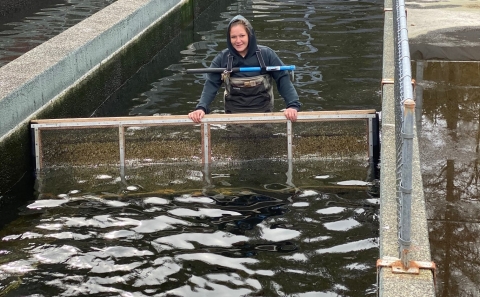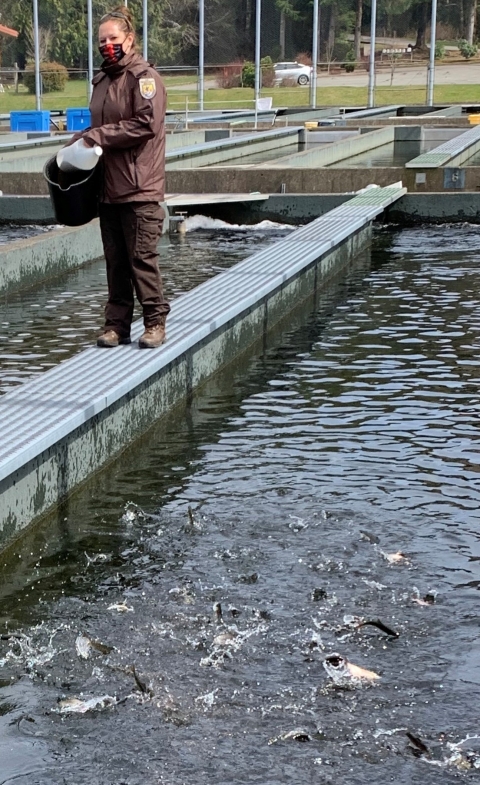Hatchery work is in Jane Lemieux’s blood.
Lemieux was literally raised at the hatchery. She’s the daughter of Ed Lemieux, who will reach 50 years of employment as a Fish Culturist at Quinault National Fish Hatchery (NFH) this August. From biking and other outdoor play around the employee housing area to fishing Cook Creek below the hatchery, she had room to roam within and around the hatchery grounds.
One can only imagine how many of the salmon she caught were raised and released by her father.
Lemieux’s interest in hatchery work continued to grow over the years. At the age of 13, she took part in the Quinault Indian Nation’s Youth Opportunity Program, where she gained official hatchery experience, including weighing food and feeding fish.
It came as no surprise when Lemieux applied for and was hired as a part-time Quinault Indian Nation Tribal Employment Rights Office (TERO) employee for the Quinault NFH in 2008. From spawning hundreds of adults to feeding and releasing millions of juvenile salmon and steelhead, the TERO employment provided Lemieux with the opportunity to bolster her fisheries experience while earning critical income for her growing family.
From 2012 forward Lemieux not only transitioned to a full-time TERO worker but began immersing herself in the U.S. Fish and Wildlife Service. By 2015, Lemieux had completed a long list of Service trainings, including cold water fish culture and heavy equipment safety training. So, when a permanent biological science technician position was advertised in 2020, she was in the perfect position to compete.
“The application process was a bit intimidating to tell you the truth, yet I felt confident with all of my experience. Getting the official job offer was both fulfilling and a relief,” Lemieux said. “I love my job. All of it. If I had to pick a favorite part, it would have to be releasing the fish because it is satisfying and rewarding to see your hard work pay off. I also like keeping up and communicating with the Tribal fishing community. They have a very positive view of the Quinault National Fish Hatchery, but I do seek out feedback to see how we can continue to improve.”
The TERO program enables the hatchery to recruit and hire local qualified tribal applicants. TERO employees are then able to support hatchery fish production operations, while gaining all the necessary skills to compete for permanent federal positions at the hatchery. Quinault NFH is fortunate to consistently produce phenomenal numbers of returning adult Coho and chum salmon, as well as winter steelhead. Thanks in no small part to Lemieux’s high-quality fish care and other Tribal employees like her, it is apparent that being culturally tied to the fish themselves creates a unique level of devotion. The welfare of reared fish ranks only second in Jane’s mind to
her children. She regularly makes personal sacrifices to be ready to respond to hatchery needs, any day, any time.
Lemieux is a perfect example of how the financial partnership between the Quinault NFH and the Tribe benefits both the community, the Service, and ecologically and culturally valuable fish that are raised and released. Like a salmon migrating upstream, all she needed was an open channel.





